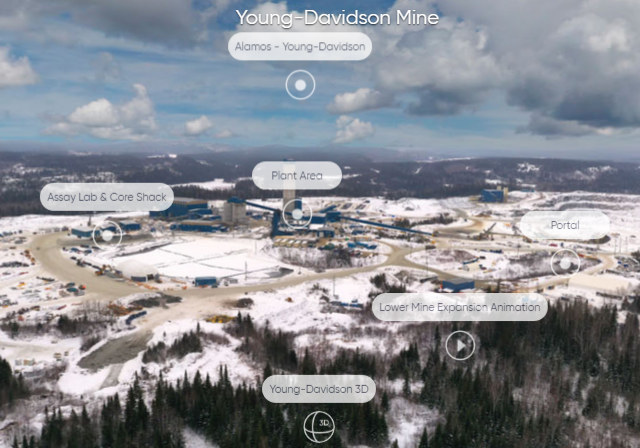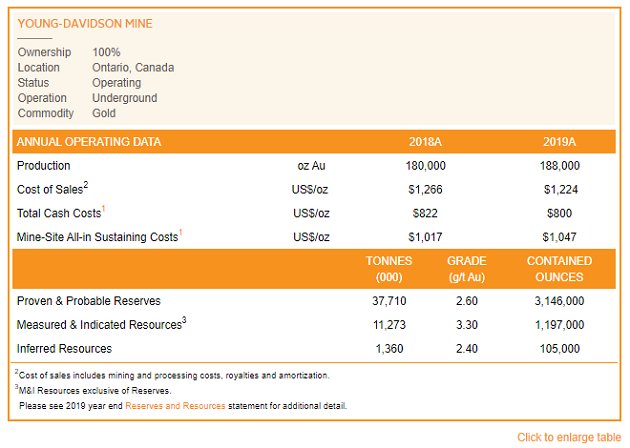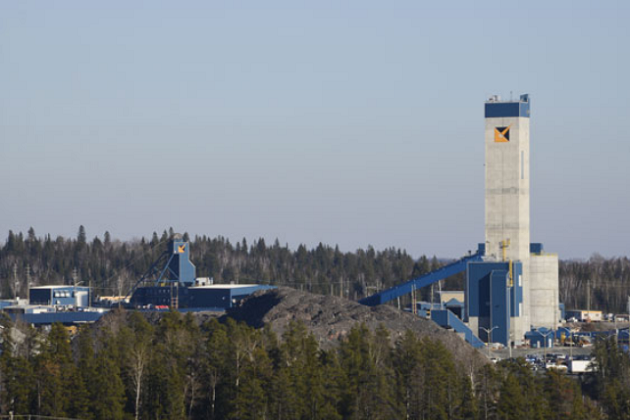Alamos Gold Inc
Young-Davidson Mine

Young-Davidson is one of our flagship operations and among Canada’s largest underground gold mines. With growing production and a large mineral reserve base, Young-Davidson is a long-life gold mine that will serve as the Company’s foundation for growth for many years to come.


OVERVIEW
The Young-Davidson mine is an underground mining operation located in Northern Ontario, Canada. The property consists of contiguous mineral leases and claims totaling 11,000 acres, and is situated on the site of two past producing mines that produced one million ounces from 1934-1957. The Young-Davidson open pit mine achieved commercial production on September 1, 2012, and on October 31, 2013, the Company declared commercial production at the Young-Davidson underground mine following the commissioning of the shaft hoisting system. Open pit mining ceased in June 2014 upon depletion of the reserve.
The underground mine has been designed for low operating costs through the use of large modern equipment, gravity movement of ore and waste through raises, shaft hoisting, minimal ore and waste re-handling, high productivity bulk mining methods and paste backfill. The mine operates scooptrams to load, haul and transfer stope production to the ore pass system from where it is hoisted to the surface via 18 tonne skips.
LOCATION
The Young-Davidson gold mine is located near the town of Matachewan, approximately 60 kilometres west of Kirkland Lake in Northern Ontario, within the southwestern part of the Abitibi Greenstone Belt. The mine is centrally located between Timmins, Kirkland Lake, North Bay and Sudbury and accessed by paved highway.
HISTORY
The initial discovery of gold in the project area was made by prospector Jake Davidson in 1916 on what became the former Young-Davidson mine. This sparked a staking rush that resulted in a second discovery by Samuel Otisse on what became the MCM Mine property. Surface prospecting, trenching and outcrop stripping continued intermittently for the next several years and a joint venture was established between Hollinger Corporation and Young-Davidson Mines Limited which led to initial underground production in 1934. Between 1934 and 1957, one million ounces of gold was produced from the Young-Davidson and MCM Mine properties. Following closure of the mines, the properties remained dormant for a number of years before seeing some exploration and other activities in the 1980s and 1990s. In 2002, a private company vended the asset into Young-Davidson Mines Limited, the same company that had discovered the property, and exploration activities were re-initiated. In late 2005, Northgate Minerals amalgamated with Young-Davidson Mines Limited, and proceeded with surface exploration, environmental and engineering studies and underground exploration and development. In 2011, AuRico Gold, a predecessor of Alamos Gold, acquired Northgate Minerals which included Young-Davidson.
Open pit mining operations commenced in November 2011 and the first gold pour was achieved in April 2012. In October 2012, the first two underground stopes came into production and on October 31, 2013, the underground mine achieved commercial production following the commissioning of the shaft hoisting system. In 2015, AuRico Gold merged with Alamos Gold.
GEOLOGY AND MINERALIZATION
Geology
Young-Davidson is situated within the southwestern part of the Abitibi Greenstone Belt, one of the largest greenstone belts in the world with historic production of 160 million ounces of gold. The Abitibi consists of a complex and diverse array of volcanic, sedimentary, and plutonic rocks typically metamorphosed to greenschist facies grade, but locally attaining amphibolite facies grade. Volcanic rocks range in composition from rhyolitic to komatiitic and commonly occur as mafic to felsic volcanic cycles. Sedimentary rocks consist of both chemical and clastic varieties and occur as both intravolcanic sequences and as uncomformably overlying sequences. A wide spectrum of mafic to felsic, pre-tectonic, syn-tectonic and post-tectonic intrusive rocks are present. All lithologies are cut by late, generally northeast-trending proterozoic diabase dikes. Within the Abitibi lies the Kirkland-Larder Lake trend, home to several gold camps including Young-Davidson, with combined historic production of 34 million ounces of gold.
Mineralization
Gold mineralization at Young-Davidson is associated with a syenite intrusive rock (a quartz granite). Within this syenite, the gold mineralization is associated with a stockwork of quartz veinlets and narrow quartz veins, rarely greater than a few centimetres thick that are within a broader halo of disseminated pyrite and potassic alteration. Historic mining demonstrated the continuity of mineralization from surface to a depth of approximately 500 metres. Mineralization is known to extend beyond 1,500 metres below surface (orebody open at depth); however, current drilling below this level will not be initiated until suitable underground drill platforms become available. Other mines along the Kirkland-Larder Lake trend were mined to depths of over 2,000 metres.
MINING AND PROCESSING
The Young-Davidson underground mine has been designed for low operating costs through the use of large modern equipment, gravity movement of ore and waste through raises, shaft hoisting, minimal ore and waste re-handling, high productivity bulk mining methods (long hole open stoping) and paste backfill. The mine operates scooptrams to load, haul and transfer stope production to the ore pass system from where it is hoisted to the surface via 18 tonne skips.
The underground mine is accessed via shaft and ramp. The sinking of the Northgate shaft was completed down to the mid-shaft loading pocket in 2013, which accesses the first eight years of mine production. Construction of the lower mine infrastructure is expected to be completed in the first half of 2020 and provides access to the lower portion of the known orebody. The existing MCM shaft reached its ultimate depth of 1,500 metres in 2015 and provides for the hoisting of personnel, materials, ore and waste. The mine will also be accessed by a ramp, which will be extended to the bottom of the mine from the existing exploration ramp.
The underground ore and stockpiled open pit ore is processed through an 8,000 tpd single stage semi-autogenous grinding circuit with a gravity circuit followed by flotation. The flotation concentrate is further ground and leached in a conventional carbon-in-leach. The flotation tailings are also leached in a carbon-in-leach circuit. The gold is recovered from the carbon followed by electro-winning and pouring doré bars. The Young-Davidson carbon-in-leach tailings are treated with the SO2/Air cyanide destruction method. The paste backfill plant was commissioned in 2014 and is capable of supplying paste fill to the underground voids at a rate in excess of 8,000 tonnes per day.
Source: https://www.alamosgold.com/mines-and-projects/producing-mine/Young-Davidson/#overview

|
Development Boomtruck Operator
- Safely move material as directed. Report and document all material moved accurately to his/her Supervisor;
- Accurately report to supervisor the material needed in storage areas U/G
Rock Breaker Operator
- Operate rock-breaker;
- Perform pre-op and post-op inspections on equipment
Scissordeck Bolter
- Install ground support as per company standard;
- Install and maintain services;
- Load development rounds
Ground Control Engineer
- QAQC of shotcrete, ground support installation, grouting, ground support auditing and paste fill;
- Document inspections of underground stoping and development;
- Rock mass characterisation and classification
Mine Engineer
- Assist with blast improvement investigations;
- Look for opportunities to improve efficiencies;
- Provide guidance to EIT’s
Construction Miner - Transmixer
- Operate equipment such as transmixer and shotcrete sprayer;
- Assist in installation, modification and repairs of UG infrastructures
Geological Technician/or Junior Geologist
- 3D digitizing of underground geological mapping and integration into 3D mining software.
- Digitize geological surface geological mapping lithology, structure and mineralization
- Digitize chip sampling of ore development headings as required
Mill Operator/Labourer
- Works and ensure all workers work in compliance with the Occupational Health & Safety Act, Regulations for Mines and Mining Plants and all other applicable government standards and regulations;
- Adheres to and enforces all safety and environmental considerations
Document Control Coordinator - Phase III
- Implement document and data management solutions with a primary focus on workflow, document control, information security and records management.
- Provide ongoing training and support to end users in the use of the document management system.
- Ensure project and operations teams comply with the document management requirements and procedures
Project Controls Manager - Phase III
- Development and implementation of project controls systems and procedures.
- Working with accounting personnel to ensure accurate reporting and approval of accruals, forecasts, and project status.
- Early identification and notification of deviations and variances to project baseline schedule and spend